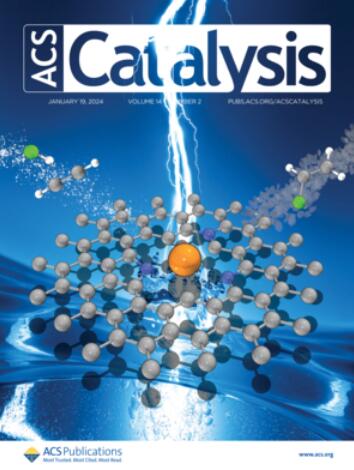Oxygen Vacancy Engineering on Pt/WOx/Nb2O5 Catalysts toward Efficient 1,3-Propanediol Production from Glycerol Hydrogenolysis
IF 11.3
1区 化学
Q1 CHEMISTRY, PHYSICAL
引用次数: 0
Abstract
The hydrogenolysis of biomass-derived glycerol to 1,3-propanediol is an important process in biomass valorization, while the selective cleavage of the secondary hydroxyl group (C2–OH) in glycerol remains a key challenge in chemistry and catalysis. We report herein a multistep approach for the construction of Pt/WOx/Nb2O5 featuring abundant oxygen vacancies and strong Ptδ+–O–W interactions thereof, making Pt/WOx/Nb2O5 a robust catalyst for glycerol hydrogenolysis to 1,3-propanediol. Typically, the optimized Pt/WOx/Nb2O5 catalyst achieves remarkable performance in the hydrogenolysis of a high-concentration glycerol solution (50.0 wt %) with a glycerol conversion of 94.9%, a 1,3-propanediol selectivity of 67.3%, and a glycerol space-time yield of 0.490 g gcat–1 h–1, surpassing all known catalyst systems. The presence of abundant oxygen vacancies in Pt/WOx/Nb2O5 is directly visualized by microscopy, and the essential role of Ptδ+–O–W interactions in the reaction is well interpreted by spectroscopic analysis. The Ptδ+–O–W interactions can promote the selective adsorption of the secondary hydroxyl group in glycerol and the hydrogen spillover from Pt to WOx for in situ Brønsted acid site generation, both facilitating the selective hydrogenolysis of glycerol to 1,3-propanediol. Overall, we show here a successful example of catalyst design via oxygen vacancy engineering for an important process, biomass valorization.

Pt/WOx/Nb2O5 催化剂上的氧空位工程,用于高效生产甘油加氢分解产生的 1,3-丙二醇
生物质衍生的甘油氢解制1,3-丙二醇是生物质增值的一个重要过程,而甘油中二级羟基(C2-OH)的选择性裂解仍然是化学和催化领域的一个关键挑战。本文报道了一种多步骤构建Pt/WOx/Nb2O5的方法,该方法具有丰富的氧空位和强的Ptδ+ -O-W相互作用,使Pt/WOx/Nb2O5成为甘油氢解制1,3-丙二醇的强大催化剂。通常,优化后的Pt/WOx/Nb2O5催化剂在高浓度甘油溶液(50.0 wt %)的氢解中表现优异,甘油转化率为94.9%,1,3-丙二醇选择性为67.3%,甘油时空产率为0.490 g gcat-1 h-1,超过了所有已知的催化剂体系。通过显微镜直接观察到Pt/WOx/Nb2O5中存在丰富的氧空位,并通过光谱分析很好地解释了Ptδ+ -O-W相互作用在反应中的重要作用。Ptδ+ -O-W相互作用可以促进甘油中仲羟基的选择性吸附和氢从Pt向WOx的溢出,从而原位生成Brønsted酸位,从而促进甘油选择性氢解生成1,3-丙二醇。总的来说,我们在这里展示了一个通过氧空位工程设计催化剂的成功例子,用于一个重要的过程,生物质增值。
本文章由计算机程序翻译,如有差异,请以英文原文为准。
求助全文
约1分钟内获得全文
求助全文
来源期刊

ACS Catalysis
CHEMISTRY, PHYSICAL-
CiteScore
20.80
自引率
6.20%
发文量
1253
审稿时长
1.5 months
期刊介绍:
ACS Catalysis is an esteemed journal that publishes original research in the fields of heterogeneous catalysis, molecular catalysis, and biocatalysis. It offers broad coverage across diverse areas such as life sciences, organometallics and synthesis, photochemistry and electrochemistry, drug discovery and synthesis, materials science, environmental protection, polymer discovery and synthesis, and energy and fuels.
The scope of the journal is to showcase innovative work in various aspects of catalysis. This includes new reactions and novel synthetic approaches utilizing known catalysts, the discovery or modification of new catalysts, elucidation of catalytic mechanisms through cutting-edge investigations, practical enhancements of existing processes, as well as conceptual advances in the field. Contributions to ACS Catalysis can encompass both experimental and theoretical research focused on catalytic molecules, macromolecules, and materials that exhibit catalytic turnover.
 求助内容:
求助内容: 应助结果提醒方式:
应助结果提醒方式:


